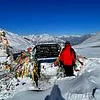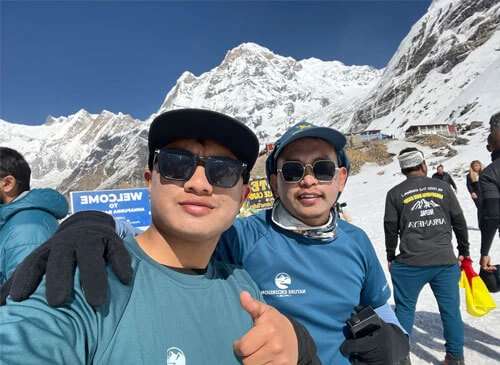The Annapurna Circuit trek is one of the most diverse and adventurous trekking routes in the Great Himalayas. Nature Excursion offers the best Annapurna Circuit trek 2024/2025 package. You will travel with friendly guides and porters. Join us now to get the best price!
On this 14-day journey, you will explore the subtropical forests and remote villages as the trail gradually ascends to the highest mountain pass in Nepal. You will follow the Kali Gadanki river valley on the way to Jomsom (2,743 m/8,999 ft) and descend to Tatopani (1,190 m/3,904 ft). You will trek through the beautiful Manang village (3,519 m/11,545 ft) and the famous pilgrimage site, Muktinath (3,710 m/12,172 ft).
To make the Annapurna Circuit trek more thrilling, you can add a side trip to Tilicho Lake to the itinerary. Check out our Annapurna Circuit trek with TilichoLake package for more information.
This is our short Annapurna Circuit trek program. You can also combine the Annapurna base camp or fly out from Jomsom village to Pokhara in our itinerary. We have a very flexible booking and customization service that lets you tailor-design any package with us according to your requirements.
The dramatic landscapes, ancient monasteries and temples, rhododendron forests, arid cliffs, and welcoming locals make the Annapurna circuit trek in Nepal one of the best trekking packages. Following the verdant hillsides and barley fields, the elevation rises as you walk from one village to another. We have a rest day in Manag village, where you'll go on an acclimatization hike to nearby places.
The Annapurna circuit trail begins in the Marshyangdi valley and further goes by the Kali Gandaki valley. Toward the end of the trek, you get to enjoy natural hot springs in Tatopani. After Tatopani, we will descend to Pokhara by driving, where the Annapurna Circuit trek of 14 days ends.
The Annapurna Circuit trek views
We love showing the breathtaking western Himalayan mountains during the Annapurna Circuit trek. The Annapurna Circuit trek photos do not do justice to the scenery. Mountains like Annapurna (8,091 m/26,545 ft), Dhaulagiri (8,167 m/26,795 ft), Hiunchuli (6,441 m/21,132 ft), Nilgiri (7,061 m/23,166 ft), Fishtail (6,993 m/22,943 ft), Tilicho Peak (7,134 m/23,406 ft), Gangapurna (7,455 m/24,459 ft), Tukuche (6,920 m/ 22,703 ft), Manaslu (8,163 m/26,781 ft), and numerous others, are seen along the Annapurna circuit trek route.
While driving from Muktinath to Tatopani, we will witness arid landscapes. The barren hills, giant rocks, white-washed houses, and apple orchards decorate the route. Likewise, the view from Poon Hill is equally enchanting. A glorious sunrise over white Himalayan massifs is just out of this world. On the Annapurna Circuit trek, you will enjoy outstanding views from every village and high point.
Thorong La pass & Muktinath temple
Crossing Thorong La pass (5,416 m/17,769 ft) is not easy. Navigating the pass is the trickiest part of the Annapurna Circuit trek. The route is steep and carries the risk of rock falls. Therefore, we do not recommend doing the Annapurna circuit trek alone and having the support of a mountain guide. Thorong La pass is also the highest point for us on this trek.
After the adrenaline of traversing Thorong La pass comes the calmness of Muktinath temple. Muktinath is an important religious place in Nepal for Hindus and Buddhists. Known as one of the 108 Divya Desams, pilgrims visit here to get salvation from their sins and moksha (liberation). As you will be circling the Annapurna range anti-clockwise, you can see Hindu and Buddhist culture side by side.
Is this trip right for you?
- The Annapurna Circuit Trek is for those who can walk 6 hours a day on uneven, steep trails. It demands high-altitude experience and perseverance to adjust to limited facilities.
- Fitness and good health are a must for a smooth journey.
- You have to be flexible and understand the Himalayas' unpredictable nature. The weather can suddenly change.
- As you go offbeat, simple teahouses become your home. You have to adjust to the available facilities.
- You have done some minor trekking before and now wish to approach more challenging trails.
A typical day on the Annapurna Circuit trek
During the trek, you will wake up early with fantastic views and a delicious breakfast. After breakfast, we leave the tea house and trek to another village, where we'll be spending the night. We have lunch on the way. While trekking, we take a break every now and then to have water and catch our breath. While passing through small settlements, we can see villagers doing their daily chores. Enjoying the warmth of the sun and the shade of the tall trees, you will follow our guide.
Annapurna circuit trek difficulty & altitude sickness
The Annapurna Circuit Trail is challenging. Out of 14 days, you will spend 11 days trekking. This trek is suitable for experienced trekkers as it traverses steep mountain trails and a high mountain pass. For beginner trekkers, the Annapurna Circuit Trek is very demanding and may put a lot of strain on the body.
Terrain: The terrain is uneven and steep. You trek through dense forests and river valleys, crossing suspension bridges and some tiny streams on rocks. A daily 5—to 6-hour walk is demanding, but you will get used to it as the days pass. After crossing Thorong La pass, the toughest part of the Annapurna circuit, the trail descends, following a rocky and arid track. The climate gets dusty and barren from Muktinath onward.
Elevation and altitude: The elevation gain during the Annapurna Circuit trek is huge. From Kathmandu, at 1,440 m/4,600 ft, you will drive to the starting point of the trek, which is Jagat (1,290 m/4,232 ft). The trail then ascends to Thorong La top at 5,416 m/17,769 ft and gradually descends to Ulleri village at 2,050 m/6,726 ft. This variation in elevation may cause altitude sickness in travelers. Therefore, acclimatization is essential during the Annapurna Circuit trek, and our itinerary has ample rest days.
Annapurna Circuit Trek Preparation
A long and challenging trek like this demands preparation that assures you of a safe and smooth journey. You do not have to undergo rigorous training for the Annapurna Circuit trek; however, daily walking and some exercise will help you a lot during the trek.
The Annapurna Circuit trek is not a marathon. Whether you do a private trek or trek in a group, you can have your own pace. The only person you will be fighting with is yourself. And to maintain pace, you have to be patient with yourself, understand your limits, and know where you can break free.
Do daily exercise. Involve cardio in your gym routine. Walk with a backpack weighing 5 kg. And do not forget to visit your doctor once before the trek begins.
Other adventurous treks in Nepal
We also organize the Annapurna Circuit trek budget. Similarly, we have many trekking packages in Nepal in different regions around the Himalayas. Some of our best recommendations are theEverest base camp trek, Mardi Himal trek, Khopra Danda trek, Langtang valley trek, Ama Dablam base camp trek, Helambu trek, and Everest view trek.
These packages will be most suitable for experienced trekkers: the Everest three passes trek, the EBC trek with Gokyo Lakes, the Upper Mustang trek, the Manaslu circuit trek, and the Makalu base camp trek.
Likewise, we have easy tours in Nepal, like the Everest base camp helicopter tour with landing, the Kathmandu, Pokhara, Chitwan tour, etc. You can customize any package with us.
The benefits of the Annapurna Circuit trek with Nature Excursion
- Free airport pick-up and drop-off as per the itinerary.
- Get trekking gear, such as a down jacket and duffel bag, for the journey (which should be returned at the end of the trek).
- Oximeter and a first-aid kit during the trek.
- Native mountain guides and porters
- Trek certificate and Nature Excursion t-shirt.
- Satellite phone to stay connected with the office team during the trek in the isolated areas.
- Free storage for your additional luggage in Kathmandu.
- In an emergency, we will provide immediate helicopter evacuation and medical assistance (involving charges payable by your travel insurance company).
- Farewell dinner at the end of the trek.




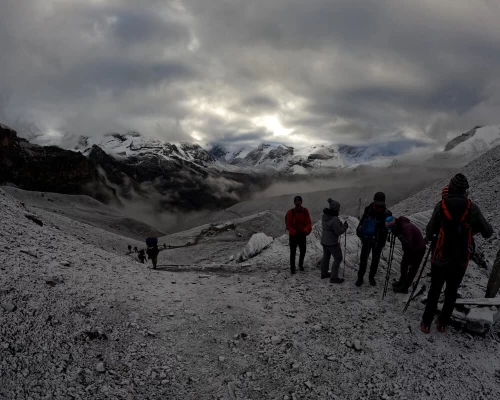
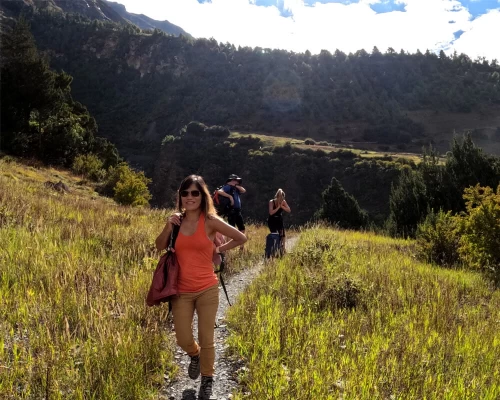
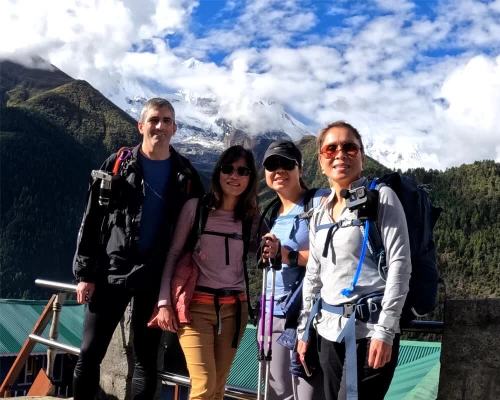
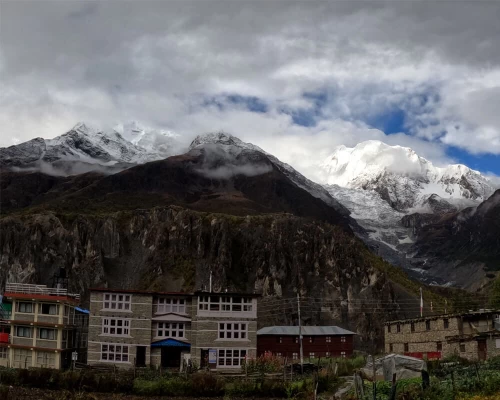


-(1).webp)
